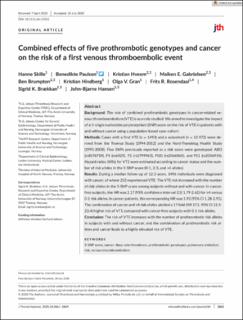| dc.contributor.author | Skille, Hanne | |
| dc.contributor.author | Paulsen, Benedikte | |
| dc.contributor.author | Hveem, Kristian | |
| dc.contributor.author | Gabrielsen, Maiken Elvestad | |
| dc.contributor.author | Brumpton, Ben Michael | |
| dc.contributor.author | Hindberg, Kristian | |
| dc.contributor.author | Gran, Olga Vikhammer | |
| dc.contributor.author | Rosendaal, Frits Richard | |
| dc.contributor.author | Brækkan, Sigrid Kufaas | |
| dc.contributor.author | Hansen, John-Bjarne | |
| dc.date.accessioned | 2021-02-09T10:57:50Z | |
| dc.date.available | 2021-02-09T10:57:50Z | |
| dc.date.created | 2021-01-25T17:41:57Z | |
| dc.date.issued | 2020 | |
| dc.identifier.citation | Journal of Thrombosis and Haemostasis. 2020, 18 (11), 2861-2869. | en_US |
| dc.identifier.issn | 1538-7933 | |
| dc.identifier.uri | https://hdl.handle.net/11250/2726867 | |
| dc.description.abstract | Background: The role of combined prothrombotic genotypes in cancer-related venous thromboembolism (VTE) is scarcely studied. We aimed to investigate the impact of a 5-single nucleotide polymorphism (SNP) score on the risk of VTE in patients with and without cancer using a population-based case-cohort. Methods: Cases with a first VTE (n = 1493) and a subcohort (n = 13 072) were derived from the Tromsø Study (1994-2012) and the Nord-Trøndelag Health Study (1995-2008). Five SNPs previously reported as a risk score were genotyped: ABO (rs8176719), F5 (rs6025), F2 (rs1799963), FGG (rs2066865), and F11 (rs2036914). Hazard ratios (HRs) for VTE were estimated according to cancer status and the number of risk alleles in the 5-SNP score (0-1, 2-3, and ≥4 alleles). Results: During a median follow-up of 12.3 years, 1496 individuals were diagnosed with cancer, of whom 232 experienced VTE. The VTE risk increased with the number of risk alleles in the 5-SNP score among subjects without and with cancer. In cancerfree subjects, the HR was 2.17 (95% confidence interval [CI] 1.79-2.62) for ≥4 versus 0-1 risk alleles. In cancer patients, the corresponding HR was 1.93 (95% CI 1.28-2.91). The combination of cancer and ≥4 risk alleles yielded a 17-fold (HR 17.1, 95% CI 12.5- 23.4) higher risk of VTE compared with cancer-free subjects with 0-1 risk alleles. Conclusion: The risk of VTE increases with the number of prothrombotic risk alleles in subjects with and without cancer, and the combination of prothrombotic risk alleles and cancer leads to a highly elevated risk of VTE | en_US |
| dc.language.iso | eng | en_US |
| dc.publisher | Wiley Online Library | en_US |
| dc.rights | Navngivelse 4.0 Internasjonal | * |
| dc.rights.uri | http://creativecommons.org/licenses/by/4.0/deed.no | * |
| dc.title | Combined effects of five prothrombotic genotypes and cancer on the risk of a first venous thromboembolic event | en_US |
| dc.type | Peer reviewed | en_US |
| dc.type | Journal article | en_US |
| dc.description.version | publishedVersion | en_US |
| dc.source.pagenumber | 2861-2869 | en_US |
| dc.source.volume | 18 | en_US |
| dc.source.journal | Journal of Thrombosis and Haemostasis | en_US |
| dc.source.issue | 11 | en_US |
| dc.identifier.doi | 10.1111/jth.15011 | |
| dc.identifier.cristin | 1878907 | |
| dc.description.localcode | This is an open access article under the terms of the Creative Commons Attribution-NonCommercial License, which permits use, distribution and reproduction in any medium, provided the original work is properly cited and is not used for commercial purposes. © 2020 The Authors. Journal of Thrombosis and Haemostasis published by Wiley Periodicals LLC on behalf of International Society on Thrombosis and Haemostasis | en_US |
| cristin.ispublished | true | |
| cristin.fulltext | original | |
| cristin.qualitycode | 2 | |

